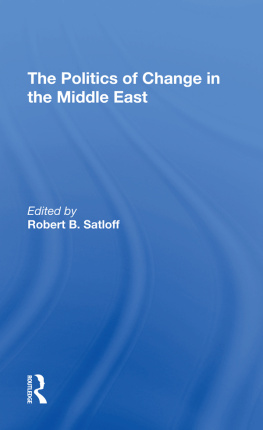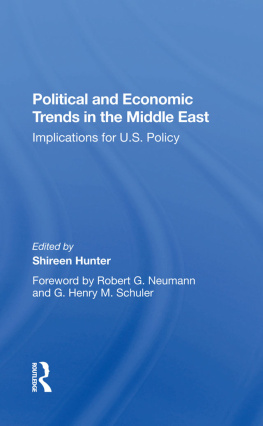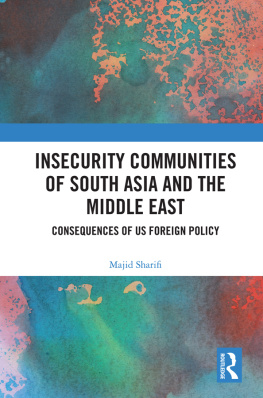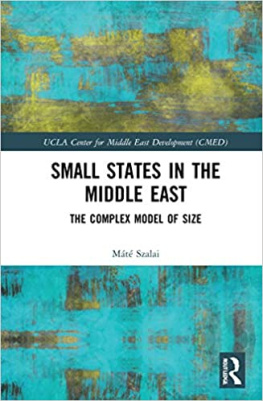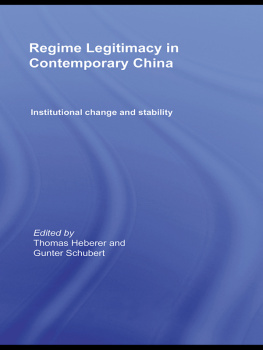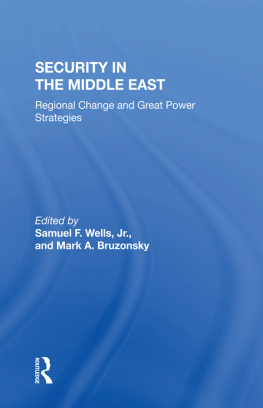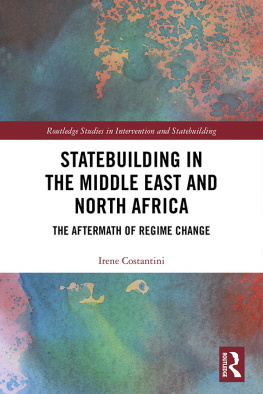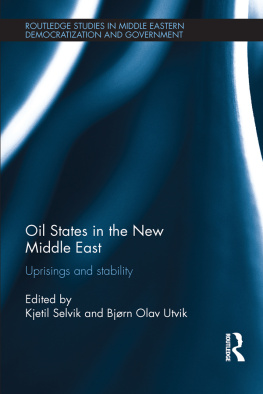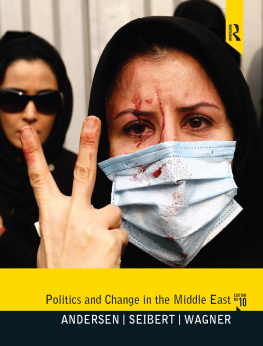First published 1993 by Westview Press
Published 2019 by Routledge
52 Vanderbilt Avenue, New York, NY 10017
2 Park Square, Milton Park, Abingdon, Oxon OX14 4RN
Routledge is an imprint of the Taylor & Francis Group, an informa business
Copyright 1993 by The Washington Institute for Near East Policy
All rights reserved. No part of this book may be reprinted or reproduced or utilised in any form or by any electronic, mechanical, or other means, now known or hereafter invented, including photocopying and recording, or in any information storage or retrieval system, without permission in writing from the publishers.
Notice:
Product or corporate names may be trademarks or registered trademarks, and are used only for identification and explanation without intent to infringe.
A CIP catalog record for this book is available from the Library of Congress.
ISBN 13: 978-0-367-29506-6 (hbk)
Robert B. Satloff
In the contemporary Middle East, threats of political instability are both real and imagined, and differentiating between the two is no easy task. Myths, such as the regions near-congenital predisposition for instability, abound, but when rapid change (e.g., Iraqs invasion of Kuwait) does occur, Western governments are often caught off-guard and unprepared.
The crescent of crisis, for example, boasts some of the longest-ruling rulers in the world, ranging from conservative monarchs like Jordans King Hussein, with more than forty years on the throne, to more eccentric leaders like Muammar Qadhdhafi, whose revolutionary credentials have become increasingly difficult to maintain after more than two decades in control of his desert republic of the masses. Of all die Middle Eastern regimes in place at the time of the 1973 Yom Kippur/Ramadan War, radical and often violent change has normally been the province of the peripheryAfghanistan, Somalia. In that time, a military coup has toppled one Arab state, Sudan; civil war and foreign intervention nearly dismembered another, Lebanon; and a third, South Yemen, was effaced through a peaceful union with its northern neighbor. But revolution, in the fullest sense of the word, occurred only in Persian, Shiite Iran, and its march was thereafter impeded by war with Iraq and by the resilience of the alarmed Sunni Arab regimes to Irans west. Indeed, throughout the rest of the twenty-odd Arab states, longevity appears to be the rule, not the exception. Moreover, when leaders themselves pass from the scene, their regimes have proved remarkably resourceful at maintaining the levers of control in the hands of one of their own, as the examples of Tunisia, Saudi Arabia, and Iraq can attest.
Longevity and stability, of course, are not synonymous; the former is not necessarily a useful, predictive tool of the latter. Indeed, straight-line forecasting can be dangerous, and the Middle East is no exception. It took several years for the debacle of the Six Day War of June 1967 to reverberate throughout the region, but when it had, the Middle East witnessed a series of fundamental leadership challenges and changes unmatched since 1948. Within four years, Egypt and Syria had new presidents; Libya, the end of the Sanussi monarchy; Iraq, the restoration of the Bath regime; and Jordan, a showdown fight between King Hussein and a Palestinian resistance that did not previously exist in a military sense. A second wave, in the late 1970s and early 1980s, marked the emergence of Islamic political activism that had been first recognized as a social and economic response to the events of 1967. In that test between regimes and Islamic oppositions, there were some shaky momentsthe 1979 takeover of the Mecca mosque, the 1981 assassination of Anwar al-Sadat, the 1982 civil revolt throughout Syriabut Arab regimes fought back ruthlessly and survived; only Shiite Iran fell to the Islamists. The third wave, less violent but no less of a threat to the existing order, is now underway in different guises in Algeria, Tunisia, Jordan, Saudi Arabia as well as in the West Bank and Gaza. Though incumbent regimes are likely to weather the storm, there is no certainty of that, and in any case, they will be changed for the experience.
Into this mix one needs to add the special ingredient of the Gulf War. Will the war reverberate among the current generation of Middle Easterners the way the 1967 war did to the previous one? The crisis certainly has all the makings of a cataclysmic event in the regions political psyche, an event which publicly broke taboos that had been previously broken only in silence on issues such as inter-Arab conflict, dependence on outside powers, and the true national priorities of various Arab regimes. Economic inequality, democracy, government accountability, military insufficiency, and the frailty of pseudo-states like Kuwait are now on the national and regional agenda in the Middle East; that the clock cannot simply be rolled back to August 1, 1990 is clear. But what is unclear is whether Middle Eastern regimes have grown so resilient over the last quarter-century that they will simply absorb or deflect these challenges or whether generational change will bring profound political change in its wake.
From an historical viewpoint, Washington does not have a stellar record of recognizing, let alone managing, change. The failure to differentiate between the U.S. national interest in the Iraq of 19801988 and the Iraq of 19881990 and to adjust policy accordingly is only die most recent of a number of analytical errors that have occurred over die past twenty years. Some, like the failure to acknowledge die depth of the domestic opposition to the Shah (or, perhaps, the Shahs unwillingness to deal forcefully with the opposition) had disastrous repercussions both for American interests and the lives of individual American citizens; others, like the failure to understand the strategic message behind Sadats expulsion of Soviet advisors in 1972, had no long-lasting damage, because Sadat was bent on re-defining Egyptian national priorities even without an early American response. When successions have occurred in recent years in countries with close ties to Washington (e.g., Tunisia, Egypt), they have tended to work smoothly, but that has usually been a function of the ruling regimes institutional need to maintain order and stability, with American diplomats, soldiers, and politicians keeping largely in the wings. Overall, die United States can be justifiably proud of its status as the major power to whom die vast majority of Middle Eastern statesArabs and Israelis, conservative monarchies and radical nationalistsnow look for security, support, and patronage. But given the fact that the Carter, Reagan, and Bush administrations were all hobbled by misjudgments about the extent and nature of change in the Persian Gulf, it often seems that whatever Pax Americana exists in die region has developed no less by default than by design.

